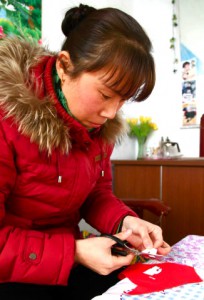 Like a vine itself, our various social media outlets have allowed ChinaVine to extend and grow in many winding ways across the globe. ChinaVine member Nan Yang has been working diligently to build our presence among the Chinese social media networks, each week continuing to cultivate and expand upon our fan base in China. Recently, she was contacted by Li Hongyun, a folk artist of the Henan Province, who learned of ChinaVine through the Chinese version of Twitter, Sina Weibo. Hongyun generously shared her motivations behind crafting a South Henan Chinese Dui Xiu Nagamaki, an embroidered and painted cloth that incorporates colorful cottons, silk, and satin to depict cultural features and ethnic customs. This piece contains approximately 1396 characters, as it authentically captures the traditional Chinese New Year’s scenery in Huang village. Hongyun further explained to Yang that, “as the traditions surrounding the Chinese New Year is diminishing, the culture surrounding traditional folk art is becoming and even further away from us. I aim to create art pieces that preserve those traditional memories.” Li Hongyun reported back to us on her artistic journey in creating folk art that honors these Chinese New Year traditions. The following was written by Hongyun, as translated by Nan Yang:
Like a vine itself, our various social media outlets have allowed ChinaVine to extend and grow in many winding ways across the globe. ChinaVine member Nan Yang has been working diligently to build our presence among the Chinese social media networks, each week continuing to cultivate and expand upon our fan base in China. Recently, she was contacted by Li Hongyun, a folk artist of the Henan Province, who learned of ChinaVine through the Chinese version of Twitter, Sina Weibo. Hongyun generously shared her motivations behind crafting a South Henan Chinese Dui Xiu Nagamaki, an embroidered and painted cloth that incorporates colorful cottons, silk, and satin to depict cultural features and ethnic customs. This piece contains approximately 1396 characters, as it authentically captures the traditional Chinese New Year’s scenery in Huang village. Hongyun further explained to Yang that, “as the traditions surrounding the Chinese New Year is diminishing, the culture surrounding traditional folk art is becoming and even further away from us. I aim to create art pieces that preserve those traditional memories.” Li Hongyun reported back to us on her artistic journey in creating folk art that honors these Chinese New Year traditions. The following was written by Hongyun, as translated by Nan Yang:
Currently in China’s larger cities, traditional ways of celebrating the Chinese New Year are growing scarce. More and more people do not know how to spend their Chinese New Year. However, inside the suburban areas, traditional New Year culture is being preserved. Yet, even inside my own village, as our elder people pass away, the practice of New Years traditions are also going away. Many people of my village have come to think the New Year is a time to rest, so many adults usually just play Mahjong together, and teenagers remain glued to their computers.
The Chinese New Year is the largest and longest festival in China; our ancestors have passed down its legacies, and it is important to sustain New Years traditions. For this reason, I started to depict the traditional scenery surrounding the Chinese New Year in my art.
The process of celebrating the Chinese New Year begins of the 23rd of December of the Chinese calendar. People purchase New Years decorations, write Chinese poetry in the form of couplets, and clean their houses. On January

1st, the first day of the Chinese New Year, it is customary for people to visit the cemetery to remember their family members that have passed on. On Jan 2nd, people celebrate at their mother-in-law’s house; by the 5th day, people create traditional folk art using wicker, yarn, fiber and wood. It is in this way that the Chinese culture thrives upon heritage and traditions. 
The piece you see here took me three years and seven months to create. I want to let more people become aware of the customary Chinese New Year traditions, and understand our nation of spiritual wealth and cultural values.
QUESTIONS:
1.) What are some customary New Years traditions you have sustained that is representative of your culture?
2.) Compare and contrast the Chinese New Year traditions to the Americans New Years traditions; what is similar? What is different?
3.) How do you think Li Hongyun’s art can effectively preserve Chinese New Years customs and traditions?
